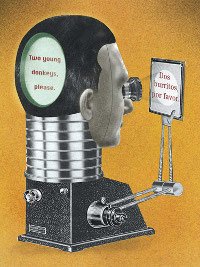| Pages in topic: < [1 2] | About double quotes, when should the form “” be allowed and avoided? Thread poster: lbone
|
|---|
neilmac
Spain
Local time: 01:39
Spanish to English
+ ...
Neil Coffey wrote:
Genuinely curious: why on earth would you possibly care what somebody in 1950 had to say about typographical practice???? Do you get a lot of clients asking you to use the typographical standards of the 1950s?
Well, how about because Fowler is still a benchmark authority on what is good English usage and style? Let's not throw the baby out with the bathwater, or send granny off to Switzerland before her time. Bill Haley still rocks...
| | | | Samuel Murray 
Netherlands
Local time: 01:39
Member (2006)
English to Afrikaans
+ ...
lbone wrote:
Double quotes in English were usually "..." to me. But now I can see more and more “...” in current English...
The proper form is the consistent form, and that varies by document and by client.
Most printed materials in English use the curly quotes. Most web sites in English use the straight quotes. This is probably because English does not contain special characters that require dead keys to type, and so most English writers are used to using only the characters that are present on the keys of the keyboard, and most English keyboards have only straight quotes on the keys.
I think many years ago, typesetting was done by a separate person, who was responsible for ensuring that the correct glyphs are used, and the translator used longhand (a pen or pencil) or sometimes a typewriter to produce the translation. Due to the limitations of the typewriter, the translator's job was not to ensure that the typographically correct characters were typed, as long as it was clear to the typesetter which character was intended in each instance.
Besides, the translator typically did not produce any material that would be directly used in the printing process, as-is (except wax sheet printing). Modern translators, however, perform many tasks that were traditionally the typesetter's duty. It would be smart (and added value), therefore, if a translator could use smart quotes in his translation, for it relieves the client of having to convert the quotes later. Also, many agency clients do not have typesetters who speak the language of the text (something that would be unthinkable in the printing industry).
I wonder why you were taught that smart quotes were bad. The answer, I think, is in the Wikipedia article: a few decades ago, when personal computers and word processing was new, most computers could not display smart quotes correctly, and if typists wanted to mimick smart quotes, they would do it using non-quote characters that looked more or less like quotes. Doing that, I think, would have been considered bad practice by purists, because the text would look very bad when viewed on a non-compatible system.
That said, I would not call straight quotes "wrong". Most users of English are familiar with straight quotes, because straight quotes are most used on web sites and e-mail, and they would not be confused by straight quotes. In addition, many fonts display curly quotes in a "straight"-looking way. For example, the Wikipedia article on quotes contains this piece of text:

...in which the quotes circled in red are "straight" and the quotes circiled in blue are "curly". One can hardly see the difference. It all depends on the font.
The main thing to remember is that one's quotation style must be consistent. Do not mix straight quotes and curly quotes in a single document. Pray that you don't encounter a TM with uneditable 100% matches that use both types of quotes.
Ask yourself (as many curly-quote fanatics won't) whether or not it's okay to mix straight quotes and curly apostrophes, or curly quotes and straight apostrophes, in a single document, e.g.:
* The phrase "don’t go" has six letters.
* The phrase “don't go” has six letters.
[Edited at 2015-01-14 20:23 GMT]
| | | | Neil Coffey 
United Kingdom
Local time: 00:39
French to English
+ ...
| Fowler's opinions and model are not "timeless" | Jan 14, 2015 |
neilmac wrote:
Well, how about because Fowler is still a benchmark authority on what is good English usage and style?
I seriously wonder if that's the case. Which reputed authors, journalists and editors for national newspapers, or indeed other professional writers such as... translators... seriously agonise over Fowler's opinions or set more store by them than other opinions?
Fowler's work certainly isn't "timeless". It was based on particular fashions and models of language of its time. (His model of grammar in particular is only "timeless" if the particular time you happen to live in is some time in the Victorian era...)
Now, you might argue that there are some aspects of usage that you wouldn't expect to have changed that much in the past few decades. But I would posit that in the case of typographical standards, there *have* been demonstrable shifts. Using as your grand benchmark reference a work written before the invention of the word processor, let alone the e-mail, just doesn't make terribly much sense to me...
| | | | | 66...99 and 6...9 | Jan 14, 2015 |
I don't know whether this is relevant, but
If/when you use smart quotes in English, then I was taught that you use the ones that look like 6 or 66 to open the quote and 9 or 99 to close it.
Unlike Danish, whish has 99 or less frequently 9 at both ends.
I do not know whether there are other variants in other languages.
I cannot persuade my keyboard to produce them in this forum: it will only produce the straight ones "..." and '...'
I was... See more I don't know whether this is relevant, but
If/when you use smart quotes in English, then I was taught that you use the ones that look like 6 or 66 to open the quote and 9 or 99 to close it.
Unlike Danish, whish has 99 or less frequently 9 at both ends.
I do not know whether there are other variants in other languages.
I cannot persuade my keyboard to produce them in this forum: it will only produce the straight ones "..." and '...'
I was taught toremember that 66 comes before 99, you have to open the quote before you can close it. ▲ Collapse
| | |
|
|
|
lbone 
China
Local time: 07:39
Member (2006)
English to Chinese
+ ...
TOPIC STARTER
Thank you everyone for sharing your knowledge, experience and opinions. I am clear now.
| | | | | Pages in topic: < [1 2] | To report site rules violations or get help, contact a site moderator: You can also contact site staff by submitting a support request » About double quotes, when should the form “” be allowed and avoided? | Wordfast Pro | Translation Memory Software for Any Platform
Exclusive discount for ProZ.com users!
Save over 13% when purchasing Wordfast Pro through ProZ.com. Wordfast is the world's #1 provider of platform-independent Translation Memory software. Consistently ranked the most user-friendly and highest value
Buy now! » |
| | Anycount & Translation Office 3000 | Translation Office 3000
Translation Office 3000 is an advanced accounting tool for freelance translators and small agencies. TO3000 easily and seamlessly integrates with the business life of professional freelance translators.
More info » |
|
| | | | X Sign in to your ProZ.com account... | | | | | |









